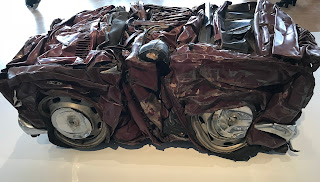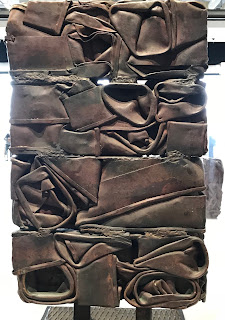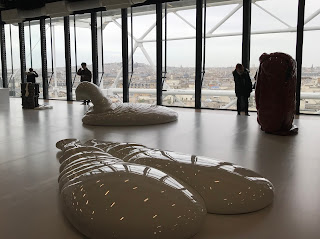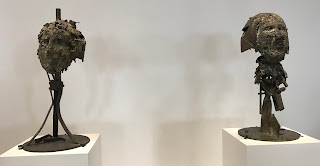BITS AND PIECES OF IRON AND METAL...
If
you have heard of César, you probably think of crushed metal, iron,
cars or something that seems to have been bashed to pieces. This is what
I am talking about…
and I imagine that most people are well aware of the thumb.
The Beaubourg had created a monumental thumb which was in front of the museum. Not being a follower of his work, I had gone to the Beaubourg to see quite another exhibition - which had finished. There was, so it seemed, no-one queuing up for the César retrospective, so I would go and have a look. I’m very glad I did. His « palette » was infinitely larger than I had ever imagined. César was born in Marseille in 1921 and died in Paris in 1998. This retrospective was for the 20 years after his death. I had read this quotation somewhere else…
« My sculpture developed in line with the possibilities offered by the materials and instruments. One of these possibilities matters to me above all: being able to destroy. This is just as important as being able to construct » (César - 1959)
The retrospective had been built around 5 concepts of experiment. However, it maybe pertinent if we discovered why he used iron. When he came to Paris in 1946, he discovered the work of Gonzalez, Giacometti and Picasso. He was not in a position to use the traditional marble and bronze for his work - lack of money - and it was this that prompted him to use scrap iron. A little later he learned the technique of arc-welding which gave him flexibility in sculpting metal. This period was described as « The Welded Irons »…Much of this work I had never seen before. That was a discovery…
« The Compressions » started in 1958 -He brought back bales of compacted metal to his studio intending to use them in his work but ended up by appreciating them as sculptures in themselves. He presented three bales of compressed motors (3 tonnes) at the Salon de Mai in 1960. He described his work then as « Controlled » impressions. They were all different even if most of them appeared to be cars..
I
I
In the next period which began in 1963, he experimented with casts of the human body. « The Human Prints. » This was when « The Thumb » emerged enlarging a cast of his thumb. This sculpture was reproduced in different sizes going from 42 cm in height to one of 12 metres!
How he did the breast of one of the Crazy Horse dancers is something else!
We move on now to « The Expansions. » Quite a new material as he began to use polyurethane foam which produced a liquid mixture that seemed to expand as César poured then swelling and not very pleasant to look. He controlled the mixture. In 1968 the direction he wanted to give to this new form of sculpture. I can’t say that these relatively small sculptures appealed to me. The foam although very smooth looked hard and not inviting to touch…they may have been innovative as these were everyday objects that he used…
He came back to earlier concepts at this point, once again using the foam which made the original sculpture look quite different.
The last period was called « The Envelopments» How strange they were. It must of been a tricky process as he was using sheets of Plexiglas which had been softened in a heating chamber and then wrapped around everyday objects. Once that had been done, there was a cooling process of around 20 minutes but apparently the material kept on making crackling noises for hours on end.
I had not followed the different concepts in an ordely manner. People were beginning to arrive, so the last photos I took a little haphazardly ...
I think that this was what had surprised me the most. His different uses of materials and techniques. I had only thought of him using welded iron. There were quite a few surprises were there not? I had taken many more photos but I thought that these were quite enough and a reasonably good view of his work. Hope you think so too?
 |
| Renault 977 VL 06, 1989 |
 |
| Griffe, 1970 |
and I imagine that most people are well aware of the thumb.
The Beaubourg had created a monumental thumb which was in front of the museum. Not being a follower of his work, I had gone to the Beaubourg to see quite another exhibition - which had finished. There was, so it seemed, no-one queuing up for the César retrospective, so I would go and have a look. I’m very glad I did. His « palette » was infinitely larger than I had ever imagined. César was born in Marseille in 1921 and died in Paris in 1998. This retrospective was for the 20 years after his death. I had read this quotation somewhere else…
« My sculpture developed in line with the possibilities offered by the materials and instruments. One of these possibilities matters to me above all: being able to destroy. This is just as important as being able to construct » (César - 1959)
 | |
| In front of the Centre |
The retrospective had been built around 5 concepts of experiment. However, it maybe pertinent if we discovered why he used iron. When he came to Paris in 1946, he discovered the work of Gonzalez, Giacometti and Picasso. He was not in a position to use the traditional marble and bronze for his work - lack of money - and it was this that prompted him to use scrap iron. A little later he learned the technique of arc-welding which gave him flexibility in sculpting metal. This period was described as « The Welded Irons »…Much of this work I had never seen before. That was a discovery…
 |
| The Rooster - 1947 |
 |
| The Rooster - 1947 |
 |
| The Bat - 1954 |
 |
| The Scorpion -1955 |
 |
| Hommage to Nicolas de Staël : 1958 |
 |
| Torso - 1954 |
 |
| The dancer - 1 |
 |
| Seated Nude - 1956 |
 | |||
| The Fish : 1954 |
 |
| The Chick- 1966 : The last in these series |
« The Compressions » started in 1958 -He brought back bales of compacted metal to his studio intending to use them in his work but ended up by appreciating them as sculptures in themselves. He presented three bales of compressed motors (3 tonnes) at the Salon de Mai in 1960. He described his work then as « Controlled » impressions. They were all different even if most of them appeared to be cars..
I
 |
| Dauphine - 1959-1970 |
 |
| Guided Compression |
 |
| Jute Sack : 1976 |
 |
| Posters -1976 |
 |
| Woman Plaque - 1963 |
I
In the next period which began in 1963, he experimented with casts of the human body. « The Human Prints. » This was when « The Thumb » emerged enlarging a cast of his thumb. This sculpture was reproduced in different sizes going from 42 cm in height to one of 12 metres!
 |
 |
| Thumb in resine 1965 |
 |
| Thumb : 1983 |
 |
| Thumb - 1965: 185x83x102 cm |
How he did the breast of one of the Crazy Horse dancers is something else!
 |
| Breast : 19 |
 |
| Breast 1967 |
We move on now to « The Expansions. » Quite a new material as he began to use polyurethane foam which produced a liquid mixture that seemed to expand as César poured then swelling and not very pleasant to look. He controlled the mixture. In 1968 the direction he wanted to give to this new form of sculpture. I can’t say that these relatively small sculptures appealed to me. The foam although very smooth looked hard and not inviting to touch…they may have been innovative as these were everyday objects that he used…
 |
| Expansion Roger Vivier : |
 |
| Expansion in cans ; 1969 |
 |
 |
| Kettle expansion :1967 |
 |
| Saucepan Expansion : 1977 |
 |
| Egg Expansion : 1967 |
He came back to earlier concepts at this point, once again using the foam which made the original sculpture look quite different.
The last period was called « The Envelopments» How strange they were. It must of been a tricky process as he was using sheets of Plexiglas which had been softened in a heating chamber and then wrapped around everyday objects. Once that had been done, there was a cooling process of around 20 minutes but apparently the material kept on making crackling noises for hours on end.
 |
| Wrapping : 1971 |
 |
| Shoes and Plexiglas |
 |
| Envelopement : 1971 |
I had not followed the different concepts in an ordely manner. People were beginning to arrive, so the last photos I took a little haphazardly ...
 |
| Giallo Naxos 594: 1988 |
 |
| Champion : 1986 |
 |
| Relief au bouquet : 1960 :Welded Iron series |
 |
| Different series |
 |
| Round Grater in Iron: 1960 |
 |
| Seated figure : 1955 : Welded iron series |
 |
| Portrait : 1957 ; Welded Iron series |
 |
| Portrait : 1957 : Welded Iron series |
 |
| Portrait : 1957 : Welded Iron series |
 |
| Victoire de Villetaneuse : 1965 : Welded Iron Series |
 |
 |
| View of the crushed cars |
 |
| Hen with rasps around 1970 |
 |
| Mask : 1972 |
 |
| Plaster : 1970 |
I think that this was what had surprised me the most. His different uses of materials and techniques. I had only thought of him using welded iron. There were quite a few surprises were there not? I had taken many more photos but I thought that these were quite enough and a reasonably good view of his work. Hope you think so too?



Commentaires